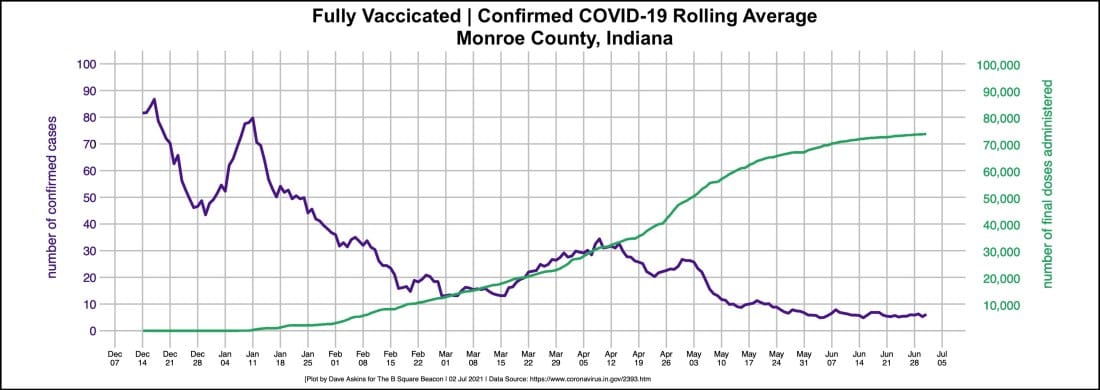Through July: Monroe County, Bloomington government meetings mostly electronic, as jabs slow, positive COVID-19 numbers stay stubborn


A key reason that Indiana governor Eric Holcomb this week issued another extension of his emergency health order is the low vaccination rate among state residents.
The order itself says: “Critically, only 48.1 percent of eligible Hoosiers are fully vaccinated and Indiana ranks 38th of the 50 states with eligible individuals receiving at least a first dose vaccination.”
Monroe County’s numbers are slightly better, but not dramatically so.
About the county’s 55.4-percent vaccination rate, among those who are eligible, county health administrator Penny Caudill said she is concerned about the 45 percent of people who are still not vaccinated. She was speaking at Friday’s weekly press conference of local leaders on pandemic response.
Local officials will be taking advantage of the governor’s health order to continue holding government meetings electronically, on a video-conferencing platform, as they have for the last 16 months. County commissioner Lee Jones said at Friday’s press conference that through July, county meetings would be held electronically, not using a hybrid approach with in-person participation.
The Bloomington mayor’s office confirmed to The B Square on Friday afternoon that the city’s boards and commissions would meet electronically, unless noted otherwise in the meeting announcement.
Caudill said the county had fallen short of her goal, which was to have 60 percent of Monroe County’s eligible residents vaccinated by July 1. Everyone 12 years and older is eligible for at least one of the vaccines that are available.
Caudill noted that in the next 60 days, the community will be going through the festival and vacation seasons, and the start of school will approach. She warned: “We can expect increased spread of the virus, if we don’t get vaccinated and get ahead of this spread.”
After starting the year at around 80 cases a day, the rolling average of confirmed positive cases in Monroe County has been in single digits since the third week of May. But since then, the rolling average has persisted at around 5 or 6 cases a day.
Over the last two weeks, the number of fully vaccinated people in the county has increased on average by only about 100 each day. That’s a sharp contrast to April numbers when on some individual days the number of additional vaccinations approached 2,000.
Vaccination, as opposed to re-instituting a mask mandate or other restrictions on behavior, is the key to the county’s strategy for keeping the lid on the pandemic.
Caudill said, “None of us want to go back to mandatory mask mandates or isolation from our loved ones, restrictions on business volumes.”
The local strategy of relying on vaccines also applies to several variants of the COVID-19 virus, including the Delta variant, which has been found to spread more quickly. In Indiana, about 60 percent of cases involve some variant. Less than 4 percent of variant cases are due to the Delta variant, based on the numbers reported by Indiana’s dashboard.
According to an AP news report, almost half (45 percent) of the variant cases in Orange County, California are currently due to the Delta variant.
The vaccination rate among the city of Bloomington’s employees is consistent with the countywide figure of around 55 percent. Bloomington mayor John Hamilton said at Friday’s press conference that 522 of the city’s roughly 900 employees had applied for the $100 credit they can receive for submitting documentation of their vaccination.
A survey of city of Bloomington employees about their reasons for not getting vaccinated could affect the way local officials approach the effort to get more people vaccinated.
At Friday’s press conference, Hamilton said about 200 city workers responded to the survey. Of those who responded, 80 percent said they were vaccinated.
According to Hamilton, for the other roughly 40 employees, the number one reason that they gave for not getting vaccinated was: too many unknowns about the vaccine.
When unvaccinated survey respondents were asked what could convince them to get vaccinated, more than half said “nothing,” Hamilton reported.




Comments ()